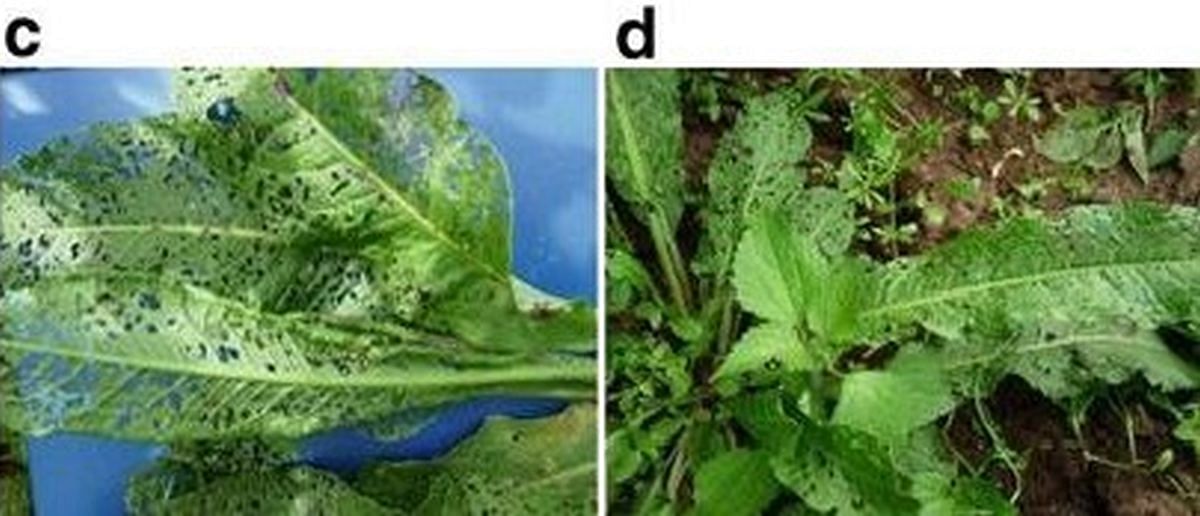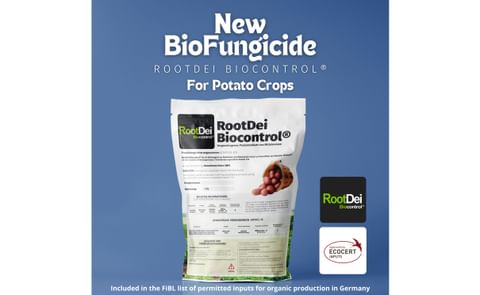Acerca de los Escarabajos Pulgas
Los escarabajos pulgas son escarabajos pequeños y saltan fácilmente en el follaje de las plantas. Su alimentación da como resultado agujeros circulares característicos de menos de 3 mm de diámetro. Las larvas que se alimentan de raíces, estolones y tubérculos también causan daños. Perforan los tubérculos superficialmente o arañan la piel, facilitando así la penetración de hongos patógenos.
Haga clic aquí para ampliar y obtener más información!
Epitrix spp. (Coleoptera: Chrysomelidae)
Distribution
Epitrix spp. is a genus of many flea beetles that are known to feed upon members of the Solanaceae family. Epitrix tuberis Gentner (1944) and E. cucumeris (Harris 1851) are common pests of potato in North America (Malumphy et al. 2016) (images below).
A nonnative pest of potato recently established and causing significant economic damage in Portugal and Spain was identified as Epitrix papa sp. n. and included in the list of quarantine pests in Europe (Eyre and Giltrap 2013; Malumphy et al. 2016; Sanchez and Vergara 2002).
Epitrix yanazara Bechyné (1959) was the major economic important species in the central highlands of Peru (Kroschel et al. 2012) which is a region with a high diversity of flea beetles (Furth et al. 2015).
Distribution
Epitrix spp. is a genus of many flea beetles that are known to feed upon members of the Solanaceae family. Epitrix tuberis Gentner (1944) and E. cucumeris (Harris 1851) are common pests of potato in North America (Malumphy et al. 2016) (images below).
A nonnative pest of potato recently established and causing significant economic damage in Portugal and Spain was identified as Epitrix papa sp. n. and included in the list of quarantine pests in Europe (Eyre and Giltrap 2013; Malumphy et al. 2016; Sanchez and Vergara 2002).
Epitrix yanazara Bechyné (1959) was the major economic important species in the central highlands of Peru (Kroschel et al. 2012) which is a region with a high diversity of flea beetles (Furth et al. 2015).

Adult damage on potato leaves (a) and larval damage on potato tuber (b). (Courtesy: CIP)
Host range
The host range comprises potato, tomato, eggplant, tobacco as well as weeds of the family Solanaceae.
The host range comprises potato, tomato, eggplant, tobacco as well as weeds of the family Solanaceae.

Heavy adult damage and infestation on a weed in potato field in Kabale, Uganda (c, d). (Courtesy: CIP)
Symptoms of infestation
Flea beetles are small beetles and jump easily in the foliage of plants. Their feeding results in characteristic circular holes less than 3 mm in diameter. Larvae that feed on roots, stolons, and tubers also cause damage. They bore the tubers superficially or scratch the skin, thus facilitating penetration of pathogenic fungi (CIP 1996; Larrain et al. 2003; Sanchez and Vergara 2002).
Flea beetles are small beetles and jump easily in the foliage of plants. Their feeding results in characteristic circular holes less than 3 mm in diameter. Larvae that feed on roots, stolons, and tubers also cause damage. They bore the tubers superficially or scratch the skin, thus facilitating penetration of pathogenic fungi (CIP 1996; Larrain et al. 2003; Sanchez and Vergara 2002).
Impacts on production losses
The flea beetles are considered one of the most serious pests threatening the entire EPPO region. In North America, they are ubiquitous. In cases of severe infestation, defoliation by adults may cause leaves to dry completely, thus affecting photosynthesis and plant yield.
Larval damage makes tubers become unviable for sale, and the destruction of the roots can result in plant death (Eyre and Giltrap 2013; Malumphy et al. 2016; Sanchez and Vergara 2002). In Peru, populations increased severely above economic thresholds if no pesticides were applied (Kroschel et al. 2012).
The flea beetles are considered one of the most serious pests threatening the entire EPPO region. In North America, they are ubiquitous. In cases of severe infestation, defoliation by adults may cause leaves to dry completely, thus affecting photosynthesis and plant yield.
Larval damage makes tubers become unviable for sale, and the destruction of the roots can result in plant death (Eyre and Giltrap 2013; Malumphy et al. 2016; Sanchez and Vergara 2002). In Peru, populations increased severely above economic thresholds if no pesticides were applied (Kroschel et al. 2012).
Methods of prevention and control
- Cultural control.
Crop rotation. Removal of host weeds and appropriate soil management to ensure vigorous potato plants contribute to reducing flea beetle populations. - Chemical control.
Many insecticides that are used to control other insect pests of potato are also effective against flea beetles. Potato plants withstand some foliage damage beyond which insecticides are required (CIP 1996; Larrain et al. 2003; Sanchez and Vergara 2002).
Explore Escarabajos Pulgas Productos

RootDei Biocontrol
RootDei Biocontrol® es un biofungicida innovador para controlar Rhizoctonia spp. en papas, formulado con la cepa T34 de Trichoderma asperellum, una sustancia activa autorizada en la UE para su uso como producto de protección de plantas.

Certis Belchim - Areli
La estrategia para controlar la fitóftora está experimentando grandes cambios. Es por eso que estamos felices de presentar Areli, el nuevo fungicida para papas. Areli ofrece una fuerte protección preventiva, incluso para los nuevos brotes. Gracias a su rápida resistencia a la lluvia, sigue siendo eficaz incluso en condiciones climáticas cambiantes.
Browse Companies Offering Escarabajos Pulgas

Mantis ULV-Sprühgeräte GmbH
Mantis ULV-Sprühgeräte GmbH develops, manufactures and sells ULV spraying systems, including MAFEX sprayers to treat potatoes with sprout inhibitors and/or fungicides

BASF
BASF is the world's leading chemical company. Specific for the potato industry BASF is a provider of herbicides, insecticides and fungicides. BASF is developing GM potato varieties, e.g. for the potato starch industry. BASF is also a manufacturer of various food ingredients.
